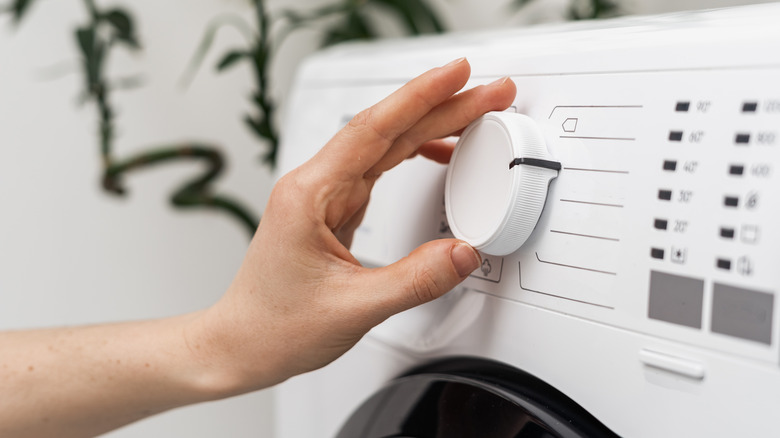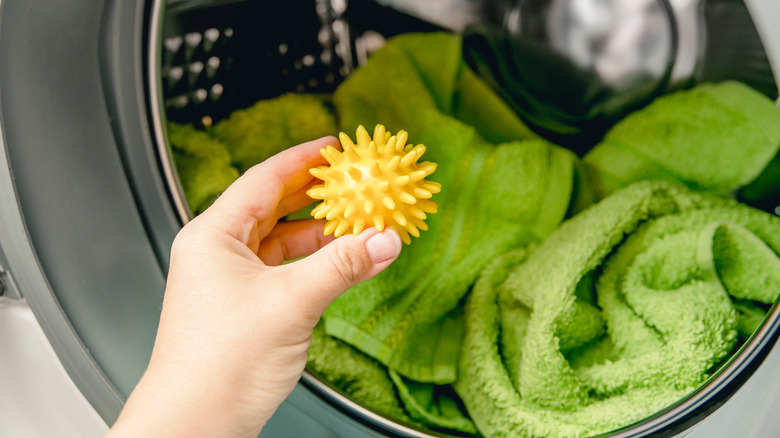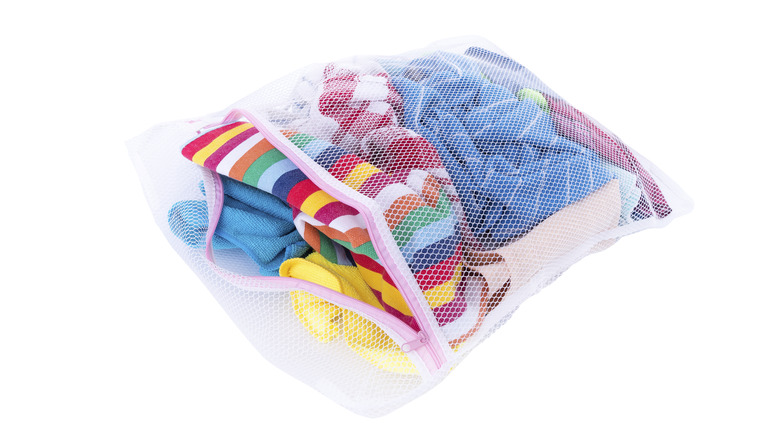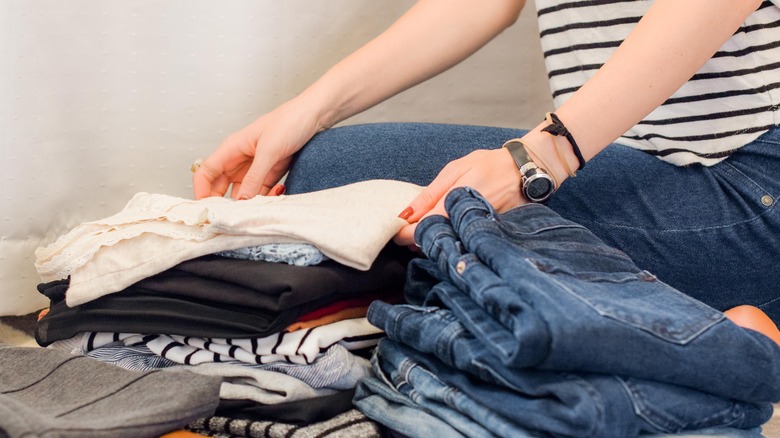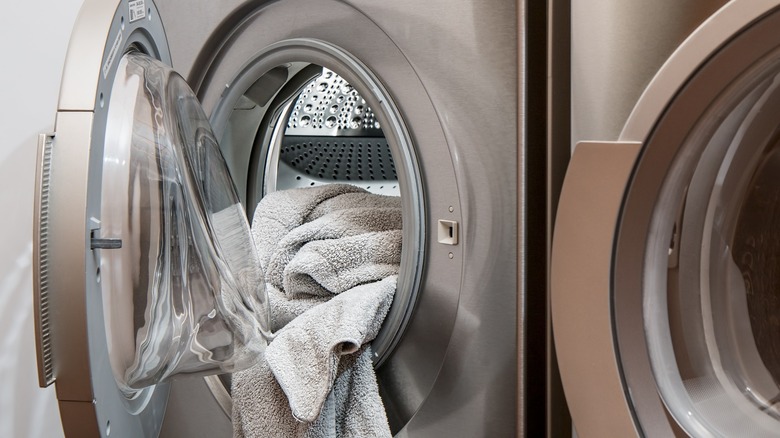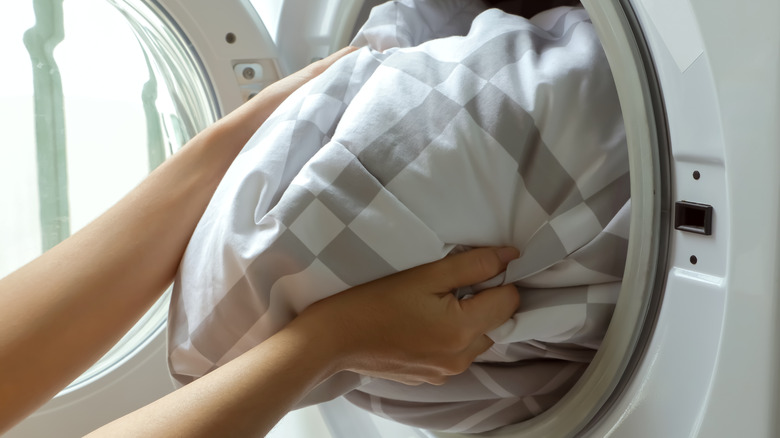All The Dryer Settings Explained
The earliest clothing dryers were invented in the 18th century, but these machines didn't become commonplace until the late 1900s. Over the decades, gas and electric models have been released, and with these designs are new controls and advancements to optimize the drying process. Most dryers have five or more preset settings which customize the dryer's temperature, run time, and cooldown period. The most common cycles are the "No Heat, "Delicate," and "Automatic" settings, though these options have alternative names depending on the dryer brand and model. You've probably noticed that more recent designs have far more than three drying options as they are becoming more optimized for specific laundry loads.
Recognizing and understanding the different dryer settings is vital for properly drying your clothes, towels, linens, and other fabrics around your home. The setting you should be using will vary depending on the garment's material type and level of dirtiness. Certain materials cannot be dried with heat or tumbling, so it's best to be aware before running your belongings through the machine. Learn more about popular dryer settings, what they mean, and what garments they should be used for in the list below.
Air dry, air fluff, or no-heat cycle
A clothes dryer doesn't need heat to operate, which is why many people call it a tumble dryer. Most dryers have a setting listed as "air dry," "air fluff," or "no-heat," which indicates the program adds no additional heat while spinning your garments. Instead of adding hot air, this cycle blows room-temperature air onto your clothes as it tumbles them.
This dryer cycle is not effective for doing standard laundry loads, but it has more niche purposes. If your clothes aren't dirty but need freshening up, you can toss them into the tumbler with a dryer sheet or ball and choose this setting. It usually takes around 15 to 20 minutes, though it can be shortened and lengthened as necessary. Using this method is also effective for softening jeans, bed linens, and blankets, hence the term "air fluff." Many garments listed as "dry clean only" can be dried on a no-heat cycle, but you must double-check their tags for instructions. If the clothing sticker reads, "Do not tumble dry," or shows a box symbol with an X over it, you should heed the instructions to keep your belongings in good condition. Generally, clothing with embellishments and silk and wool fabrics shouldn't be tossed around, even on a no-heat cycle.
Delicate or gentle cycle
The delicate or gentle setting is less intense than other dryer options, making it ideal for soft and fragile fabrics. You can identify these fabrics by their tags, which list the material type and washing and drying instructions. The tag details should inform you to use the gentle cycle or have an icon that indicates low-heat dry methods. There will either be a circle enclosed in a box with two lines underneath or a circle with a dot in the middle. Most garments made with chiffon, lace, linen, or spandex have these instructions since they are susceptible to damage when dried on high heat. Extreme temperatures fade colors, cause piling or tears, and generally weaken the material.
Instead of drying these clothes quickly with hot air, you should use the delicate cycle with its low heat and longer run time. However, you should know that some dryers still reach temperatures of up to 125 degrees Fahrenheit on this setting, which may be too hot for your delicates. If you aren't familiar with your dryer, you should check on the clothes in 10-minute intervals to make sure they aren't getting too hot. You can also use a garment bag, which is typically made from nylon, polyester, or vinyl, to protect more delicate pieces. Garment bags are also useful for keeping items organized during tumbling, by holding your socks, underwear, neckties, and other small garments in one place. This is especially useful for pieces with sequins, embellishments, or strings since they won't get snagged in the bag.
Permanent press, wrinkle-control, or wrinkle-resistant setting
Modern dryers have advanced to being designed with cycles that prevent wrinkling, which is a common issue with cotton, hemp, and linen-based fabrics. This setting runs on medium heat with a cooldown period, making it less damaging on your clothes than using a high-heat clothing iron. Turning your dryer dial to permanent press is the best course of action for synthetic fabrics, such as polyester blends, which are usually already designed to minimize wrinkling.
Combining a synthetically-made garment with a wrinkle-control cycle can save you the time and effort it typically takes to iron out your clothes. However, you must hang up or fold your items immediately after they come out of the dryer to keep the wrinkles at bay. Leaving them in a jumbled mess will cause creasing as they cool, making it imperative that you put them away as soon as possible.
Automatic, mixed load, or timed dry cycle
The most common dryer cycle is the "automatic" option, which is the most efficient for drying your clothes. This option uses medium heat and a high spin or tumble setting to thoroughly dry items that have been through the wash. Cotton, linen, polyester, and other mixed fabrics are usually safe to put through this cycle, but you should check the tag just as you would for a "delicate" or "air fluff" labeled garment. Tags with a single circle symbol or a circle enclosed in a square icon indicate that your fabric can be dried normally.
As a general rule, you should be cautious about placing non-mixed materials in a dryer in this setting. Textiles that are 100% cotton, linen, and wool are likely to shrink when wet and exposed to high temperatures, making this program a risky choice. If you're confident your delicate items will hold up on a mixed-load setting, you should again consider investing in a mesh bag to provide protection during this cycle.
Heavy-duty cycle
Heavy-duty cycles are either labeled as such or named after garments and items best suited for this method. You may see buttons on your dryer panel like "jeans," "towels," "bedding," or other items that can typically withstand high heat, high spin speeds, and low time limits. Basically, this method is optimized to dry your bulkiest laundry loads, such as blankets, comforters, jeans, robes, towels, tablecloths, and winter coats. Keep in mind that you should only place winter coats in this cycle if the outerwear tag indicates it can withstand high temperatures. When a jacket has synthetic fur, a soft inside, or other embellishments, it can be damaged by the heavy-duty dry cycle.
This load setting uses the most energy since it has to work harder and longer to dry your thickest materials. When you place the correct items in your machine with this program, they will come out feeling completely dry, soft, and fluffy. If your things are coming out damp, they are likely too heavy and dense, and you may need to put them through your dryer in sequence.
Warm-up setting
A "warm-up"' setting is usually found on more advanced dryers with extensive setting options. This quick button puts additional time on current cycles or is used on its own to warm up your clothes. It typically adds 10 minutes of high heat to your items, which is convenient for multiple functions. If you want to warm your towels or blankets before taking a shower or going to sleep, you can use this setting to make your linens extra cozy. You can also utilize this button to finish drying items that may not have been thoroughly dried in a previous cycle.
All you must keep in mind is that this setting outputs high heat, meaning you should only use it on fabrics with the corresponding icon on their wash instructions. Items that are 100% cotton, linen, and wool won't be as likely to shrink on this setting as long as they aren't too damp. However, they will still be vulnerable to potential damage if they aren't designed to withstand standard dryer cycles.
Quick dry or fast dry cycle
The quick dry or fast dry setting is similar to the "warm-up" program in that it is a brief, high-temperature cycle based on a timer. Drying a small to medium-sized load usually takes 20 minutes or less to dry — the smaller the load, the less time it will take. You should not use this method on bulky items or large loads, for the drying won't be consistent due to the limited time frame. On many dryer models, this program is set to a specific time allotment, meaning the cycle won't end even if your dryer has auto shutoff capabilities.
Be wary of the fabrics you place in this setting, so you don't accidentally damage or shrink them with high heat. You should know that polyester and polyester blends don't absorb moisture as easily as other fabrics and dry very quickly. Due to these natural qualities, it is the safest fabric to place on this setting.
Sanitize program
Newer and more advanced dryer systems come with a sanitizing cycle option that runs extra hot to purge your garments of bacteria and grime. This setting is handy when you have household members that work in messier environments or lead especially active lifestyles. It can also help you eliminate germs when someone is sick, helping to prevent viruses from spreading.
When clothes become damp, sweaty, or are exposed to contagions, it may take extra heat to kill off dangerous bacteria. The sanitize setting is designed explicitly for this purpose, and it reaches temperatures above 140 degrees Fahrenheit to kill off 99.9% of common household bacteria: S. aureus, P. aeruginosa, and K. pneumoniae. You shouldn't use this cycle every week, as the high temperatures will quickly degrade materials if used excessively. Get the best results from this program by using it with the sanitary setting on your washing machine and fabric sanitizer products.
Steam cycle
Another program that is only found on specialized dryer appliances is a steam cycle. In some appliances, this program requires you to hook up your dryer to a plumbing pipeline due to its unique water feature. Its purpose is similar to the air dry, air fluff, and no-heat cycles and permanent press, wrinkle-control, and wrinkle-resistant cycles in that it's meant to eliminate the need for dry cleaning and ironing.
During the steam cycle, a light spray of water is released over the clothes to gently steam them as they dry. This removes wrinkles and softens the fabric, eliminating the need for ironing if you immediately hang up or fold your clothes. This process also removes the need for general professional dry cleaning, as you can wash these items from home. (However, you will still need to take soiled or stained dry clean items in for professional clean up). You can also use this dryer setting to routinely tumble your jeans and bulky outwear, so you can wash them less often.
